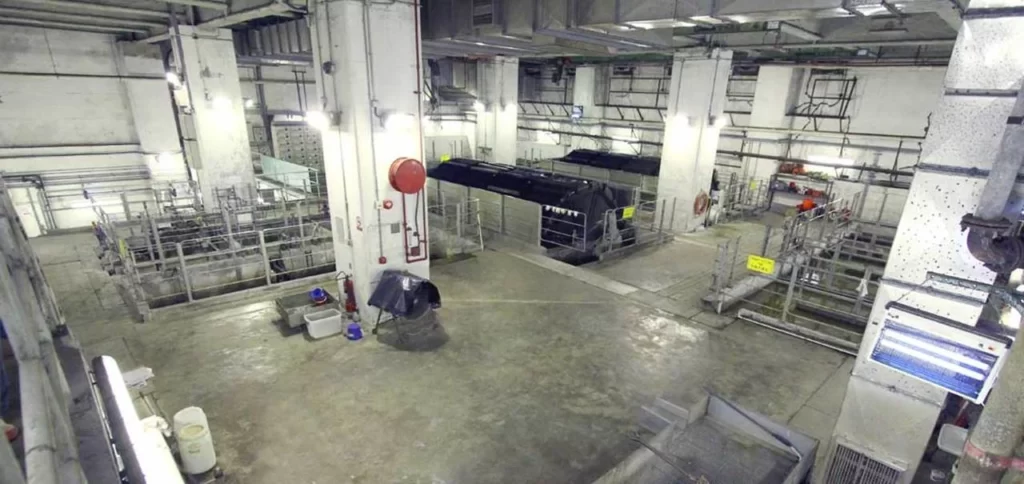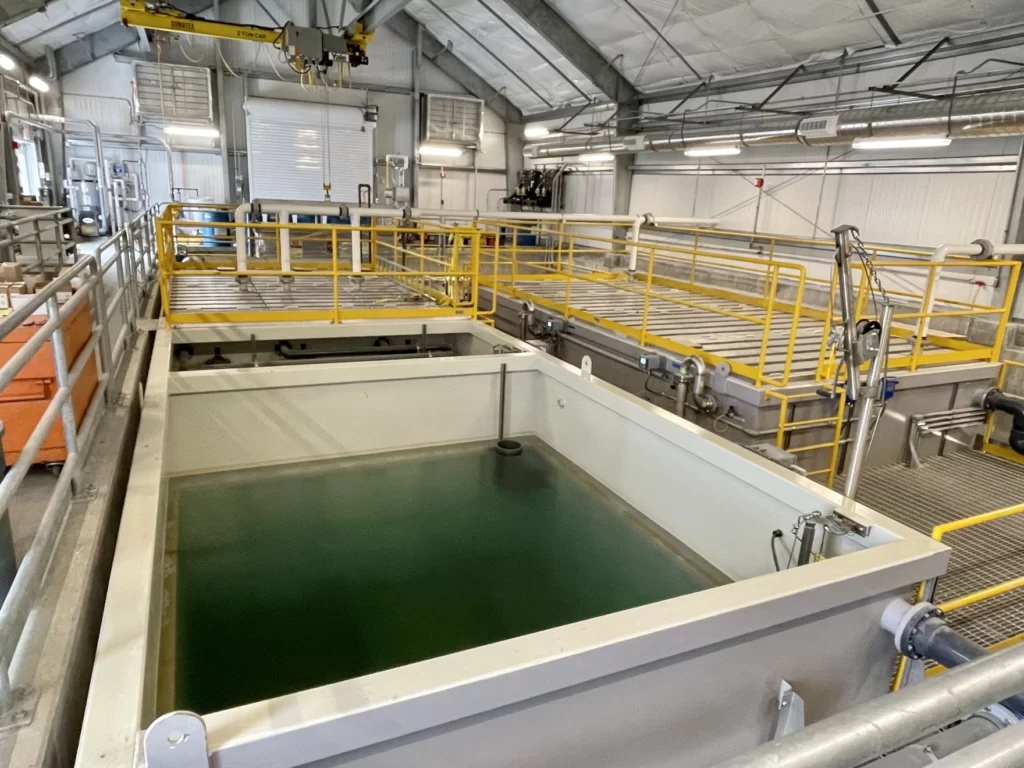STP waterproofing (Sewage Treatment Plant)


waste water management using stp
Once the wastewater has been treated, it can be safely discharged into nearby bodies of water or reused for various purposes, such as irrigation or industrial processes. Proper sewage treatment is essential for protecting public health and the environment and promoting sustainable water use.
STP Waterproofing
Waterproofing treatment for Sewage Treatment Plants (STPs) is essential to prevent water leakage and seepage from the tank walls and floors. Leakage and seepage can lead to contamination of the groundwater, soil, and adjacent structures, and can also affect the efficiency of the treatment process.
STP waterproofing: SEVERAL methods available, including:
- Bituminous Coating: Bituminous coating is a black, tar-like material that is applied to the walls and floors of the tank. It is highly resistant to water and chemicals and forms a durable barrier against water leakage and seepage.
- Polymer Coating: Polymer coating is a liquid-applied waterproofing system that is sprayed or rolled onto the tank walls and floors. This coating is highly flexible and can withstand movement in the substrate without cracking, making it ideal for large structures like STPs.
- Membrane Waterproofing: Membrane waterproofing is a sheet-like material that is applied to the walls and floors of the tank. This material is highly resistant to water and chemicals and forms a strong barrier against water leakage and seepage.
How to choose a method of waterproofing of sTP which is apt for you?
The choice of waterproofing method will depend on several factors, including the size of the tank, the level of groundwater, and the type of waste being treated. It is important to choose a reliable and experienced contractor for the waterproofing treatment of STPs to ensure that the treatment is effective and long-lasting.
Protection coatings for STP
Addition to the primary waterproofing inside the STP, a protection coating is required act as a barrier between the structure and the contaminated water. Protection coating inside STP refers to a coating system applied to the interior surfaces of the STP tanks to protect them from chemical attack, corrosion, and abrasion. The protection coating can prolong the life of the STP tanks and ensure the efficient operation of the treatment process.
The protection coating inside STP can be made of various materials, including epoxy, polyurethane, and vinyl ester. These coatings provide excellent protection against corrosion, chemicals, and abrasion, and are resistant to bacterial and fungal growth. The choice of coating material will depend on several factors, including the type of wastewater being treated, the temperature, and the level of chemical exposure.
How to apply the protection coatings?
Protection coating system typically consists of several layers, including a primer, a base coat, and a topcoat. The primer is applied first to ensure good adhesion to the substrate. The base coat provides the main protection against chemical attack and abrasion, while the topcoat provides additional protection and a smooth, easy-to-clean surface.
The protection coating inside STP should be applied by experienced and qualified professionals to ensure proper adhesion and curing. Regular inspection and maintenance of the coating system should also be carried out to ensure its effectiveness and longevity.

Crucial nature of STP
In summary, protection coating inside STP is an essential component of the treatment process to ensure the longevity and efficient operation of the STP tanks. The selection of the appropriate coating system and proper application are critical for effective protection against corrosion, chemical attack, and abrasion.
Geoliz Waterproofers Pvt. Ltd. has vast experience in specifying and execution of Sewage treatment plant waterproofing and protection treatment. We have handled sewage treatment plant that are below ground level and that are above ground level efficiently using different systems and leading waterproofing brands available in the market.
waterproofing of STP’s below natural ground level
Waterproofing large sewage treatment plants that are located below ground level can be a challenging task. However, there are several effective strategies that can be employed to ensure that these structures remain waterproof and protected from water infiltration. Here are some of the key steps that can be taken:
- Use quality waterproofing materials: It is essential to use high-quality waterproofing materials that are specifically designed for below-grade applications. Some of the commonly used materials include waterproofing membranes, sealants, and coatings.
- Proper surface preparation: Before applying waterproofing materials, the surface of the sewage treatment plant must be properly prepared. This includes cleaning the surface thoroughly and repairing any cracks, joints, or other defects.
- Ensure proper drainage: Proper drainage is crucial to prevent water from accumulating around the sewage treatment plant. This can be achieved by installing drainage systems such as French drains, sump pumps, and other drainage systems.
- Consider the hydrostatic pressure: Hydrostatic pressure is the pressure exerted by groundwater on the walls of the sewage treatment plant. To effectively waterproof the plant, it is essential to consider the hydrostatic pressure and choose waterproofing materials that can withstand this pressure.
- Regular maintenance: Regular inspection and maintenance of the waterproofing system can help to identify any issues early on and prevent water infiltration. This can include checking for cracks, leaks, and other defects, and repairing them promptly.
Overall, effective waterproofing of large sewage treatment plants that are located below ground level requires careful planning, proper selection of materials, and regular maintenance. By following these steps, you can ensure that your sewage treatment plant remains protected from water infiltration and performs efficiently.
Waterproofing treatment of STP
Waterproofing treatment for Sewage Treatment Plants (STPs) is essential to prevent water leakage and seepage from the tank walls and floors. Leakage and seepage can lead to contamination of the groundwater, soil, and adjacent structures, and can also affect the efficiency of the treatment process.
There are several waterproofing methods available for STPs, including:
- Bituminous Coating: Bituminous coating is a black, tar-like material that is applied to the walls and floors of the tank. It is highly resistant to water and chemicals and forms a durable barrier against water leakage and seepage.
- Polymer Coating: Polymer coating is a liquid-applied waterproofing system that is sprayed or rolled onto the tank walls and floors. This coating is highly flexible and can withstand movement in the substrate without cracking, making it ideal for large structures like STPs.
- Membrane Waterproofing: Membrane waterproofing is a sheet-like material that is applied to the walls and floors of the tank. This material is highly resistant to water and chemicals and forms a strong barrier against water leakage and seepage.
Repairing and waterproofing an old STP
The repair process for waterproofing an old sewage treatment plant (STP) will depend on the specific issues that need to be addressed. Here are the general steps involved in repairing and waterproofing an old STP:
- Inspection: The first step in repairing an old STP is to conduct a thorough inspection to identify any areas where water is entering the structure or where the waterproofing system has failed. This may involve a visual inspection or more specialized testing techniques such as infrared thermography or moisture mapping.
- Surface preparation: Once the areas of concern have been identified, the next step is to prepare the surface of the STP for repairs. This may involve cleaning the surface, removing any loose or deteriorated materials, and repairing any cracks, joints, or other defects.
- Application of waterproofing materials: After the surface has been properly prepared, the next step is to apply the appropriate waterproofing materials. This may involve the use of liquid-applied membranes, sheet membranes, coatings, or sealants, depending on the specific needs of the project.
- Quality control and testing: After the waterproofing materials have been applied, it is important to perform quality control checks to ensure that the repair has been properly completed. This may involve testing the waterproofing system for leaks or other issues using specialized equipment.
- Ongoing maintenance: Finally, it is important to establish an ongoing maintenance program to ensure that the waterproofing system remains effective over time. This may involve regular inspections, repairs as needed, and other measures to prevent water infiltration and ensure the long-term performance of the STP.
Repairing and waterproofing an old STP can be a complex process that requires specialized knowledge and experience. It is important to work with a qualified waterproofing professional to assess the specific needs of the project and develop a comprehensive repair and maintenance plan that meets the required performance standards.
Advanced waterproofing systems for Sewage treatment plants
- Crystalline waterproofing: This system uses a chemical treatment that reacts with water to form crystals within the concrete, effectively blocking the pores and preventing water from penetrating. This can be an effective way to waterproof large concrete structures, such as STP tanks and basins.
- Spray-applied waterproofing: This system involves the application of a spray-applied membrane to the surface of the concrete. The membrane forms a seamless, durable barrier that can provide long-lasting protection against water and other contaminants.
- Composite waterproofing: This system combines different types of waterproofing materials, such as a spray-applied membrane and a cementitious coating, to provide enhanced protection against water and other contaminants. The combination of materials can provide greater durability and a longer service life than single-layer systems.
- Geomembrane liners: This system involves the installation of a high-density polyethylene (HDPE) or other synthetic liner within the STP tank or basin. The liner provides a durable, waterproof barrier that can withstand high levels of water pressure and resist damage from chemicals and other contaminants.
Advanced waterproofing systems for STPs can provide increased durability, protection, and longevity compared to traditional waterproofing methods. However, it is important to select the appropriate system for the specific needs of the project and to work with a qualified professional to ensure proper installation and maintenance.

Challenges in waterproofing of STP that are open to the sunlight
Waterproofing sewage treatment plants (STPs) that are exposed to sunlight can pose some unique challenges compared to STPs that are located underground. Here are some of the main challenges that can arise:
- UV radiation: Exposure to sunlight can cause damage to waterproofing materials over time due to the effects of UV radiation. This can cause materials to degrade, crack, and become less effective at preventing water infiltration.
- Thermal cycling: Large temperature fluctuations caused by exposure to sunlight can cause waterproofing materials to expand and contract, leading to cracking and other forms of damage.
- Weathering: STPs that are exposed to sunlight are also more susceptible to other forms of weathering such as wind, rain, and hail, which can further damage waterproofing materials.
- Aesthetics: STPs that are exposed to sunlight are often located in more visible areas and can have an impact on the visual appearance of a site. This can make it challenging to select waterproofing materials that are both effective and visually appealing.
To effectively waterproof an STP that is exposed to sunlight, it is important to consider these challenges and choose materials that are designed to withstand UV radiation, thermal cycling, and other forms of weathering. It is also important to ensure that the materials are properly installed and maintained to minimize the risk of damage over time. Some options for waterproofing exposed STPs include UV-resistant coatings, thermoplastic or thermoset membranes, and liquid-applied membranes that can be installed quickly and easily. By working with a qualified waterproofing professional and selecting the right materials, it is possible to effectively waterproof an STP that is exposed to sunlight and protect it from water infiltration for years to come.
The cost of waterproofing and protection system for a sewage treatment plant (STP)
The cost of waterproofing and protection system for a sewage treatment plant (STP) can vary widely depending on a variety of factors such as the size of the plant, the complexity of the design, the type of waterproofing system used, and the site-specific conditions. Here are some of the key factors that can impact the cost of waterproofing and protection system for an STP:
- Size and complexity of the plant: The larger and more complex the STP, the more expensive it will be to waterproof and protect. A larger plant will require more materials and labor to waterproof, and a more complex design may require specialized waterproofing techniques.
- Type of waterproofing system: The type of waterproofing system used can also impact the cost. Different materials and techniques can vary in cost, and some may require more labor or special equipment to install.
- Site-specific conditions: The site-specific conditions can also impact the cost of waterproofing and protection system for an STP. For example, if the site is located in an area with high groundwater or flood risk, additional measures may be required to ensure the STP remains protected.
- Maintenance and repair costs: It is also important to consider the ongoing maintenance and repair costs of the waterproofing and protection system. Regular inspections and maintenance may be required to ensure the system remains effective and to identify any issues early on.
Overall, the cost of waterproofing and protection system for an STP can range from a few thousand Rupees to couple of lacs or more, depending on the factors discussed above. It is important to work with a qualified waterproofing professional like Geoliz Waterproofers Pvt. Ltd. to assess the specific needs of the project and develop a cost-effective solution that meets the required performance standards.
limitation of protection coatings for Sewage Treatment plants
While protective coatings can be an effective way to prevent corrosion and other forms of damage to sewage treatment plant (STP) infrastructure, there are some limitations to their use. Here are some of the most common limitations of protection coatings:
- Surface preparation: In order for a protective coating to be effective, the surface of the STP must be properly prepared. This may involve cleaning, sandblasting, or other techniques to remove contaminants and create a clean, dry surface. If surface preparation is not done properly, the coating may not adhere properly and may fail prematurely.
- Compatibility: It is important to select a protective coating that is compatible with the materials being protected and the specific environmental conditions of the STP. Failure to do so may result in premature coating failure or other performance issues.
- Installation: Proper installation is critical to the performance of a protective coating. Improper application, such as insufficient coating thickness, can lead to failure of the coating and damage to the underlying substrate.
- Maintenance: Protective coatings require ongoing maintenance to remain effective. Failure to properly maintain the coating, such as by neglecting to repair damaged areas or recoat as necessary, can result in premature coating failure and damage to the underlying substrate.
- Exposure: Some environmental conditions, such as high temperatures or exposure to corrosive chemicals, may exceed the capabilities of protective coatings. In these situations, alternative corrosion protection measures may be necessary.
- Aging and deterioration: Over time, even the most durable protective coatings will begin to deteriorate due to exposure to environmental factors and wear and tear. As coatings age, they may become less effective at protecting the underlying substrate.
While protective coatings have many benefits and can be an effective way to prevent damage to STP infrastructure, it is important to be aware of these limitations and to develop a comprehensive maintenance plan to ensure long-term performance.
